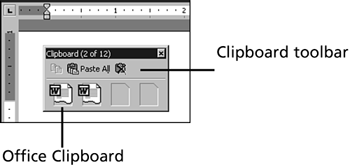Cutting and Pasting
| The capability to move and copy text from one place to another is one of the most appreciated features of word processing programs. The term cutting and pasting actually refers to both moving and copying text. When you move text, you remove ( cut ) it from one location in your document and paste it in another. When you copy text, you leave the text in its original location and paste a duplicate of it somewhere else. The location that contains the text you want to move or copy is called the source , and the place you want to paste it is called the destination. The destination can be in the same document, another Word document, another Office document (such as an Excel spreadsheet or a PowerPoint presentation), or a document created in another Windows application. When you cut or copy text, it is placed on the Windows Clipboard, a temporary storage area available to all Windows applications. Issuing the Paste command copies the text from the Windows Clipboard into your document. (It actually stays on the Windows Clipboard until you perform the next cut or copy, so you can paste the same text multiple times if you like.) Moving TextAs you're typing a document, you'll probably want to restructure it a bit. You may need to move a word or phrase within a sentence , reorganize the flow of sentences within a paragraph, or change the order of some paragraphs. Follow these steps to move text:
Copying TextIf you want to insert a block of text that you've already typed somewhere else, it's much faster to copy it than to type it from scratch. Follow these steps to copy text:
Moving and Copying with Drag-and-DropIf you are handy with the mouse, you may find it easiest to move and copy text with drag-and-drop. This feature enables you to select text and then drag it to its destination. Drag-and-drop is best suited for moving or copying small amounts of text a short distance. To move text with drag-and-drop, select the text that you want to move or copy and release the mouse button. Point to the selected text. The mouse pointer becomes a white arrow. Drag the selection to the destination. As you drag, the mouse pointer indicates that you're performing a drag-and-drop. Drag until the dashed insertion point attached to the mouse pointer is in the right place, and then release the mouse button. To copy the text instead of dragging it, Ctrl+drag it to the destination (hold down the Ctrl key as you drag). The drag-and-drop mouse pointer gains a plus sign to indicate that you're performing a copy, not a move. When the dashed insertion point is in the right place, release the mouse button and then the Ctrl key. (If you release the Ctrl key before the mouse button, Word performs a cut instead of a copy.) Once you drag or copy the text, click in the document anywhere to deselect the text. If you accidentally drop the selected text in the wrong place, click the Undo button on the Standard toolbar. Moving and Copying Multiple ItemsWith the traditional cut-and-paste procedure, you can cut or copy only one selection at a time. The Office Clipboard, enables you to "collect" up to 12 (24 with Office XP and later) selections of cut or copied data and then paste them in any order into any Office document. The Office Clipboard can handle all of the standard data types, including text, numbers , graphic images, and so on. To practice using the Office Clipboard, follow these steps:
When the Clipboard toolbar is visible, you can cut or copy items from any Windows application to the Office Clipboard. (When it isn't visible, you can still use it to cut or copy items in an Office application.) Items that you've cut or copied from applications other than Word show as icons that match those applications. |
EAN: 2147483647
Pages: 474
